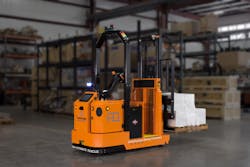Safety drives shift to autonomous mobile robots
Autonomous mobile robots (AMRs) are improving worker safety at plastics processing facilities by replacing manually operated forklifts in high-traffic areas.
AMRs use sensors, including lidar laser sensors, to detect people and objects, allowing them to stop or maneuver to avoid collisions.
The robots can deliver resin to processing machines, transport finished products to a palletizing station, move palletized goods to a stretch-wrapping system and then take the wrapped pallets to a warehouse or truck.
“The most prevalent applications are going to be at the front of the line and at the end of the line,” said Josh Cloer, sales director for the Eastern U.S. for Mobile Industrial Robots (MiR).
The company’s two largest AMRs, the MiR 500 and the MiR 1000, can eliminate the use of manually operated fork trucks in areas with lots of pedestrian traffic, Cloer said. Forklift operator errors can lead to injuries, he added.
Rob Sullivan, CEO of AutoGuide Mobile Robots, agreed.
“One of the biggest hazards in warehousing is foot injuries, where the fork trucks will run over people’s feet,” Sullivan said.
A full load can block a forklift operator’s line of sight, creating the potential for pedestrians to become trapped between the forklift and another object. AMRs use sensors to avoid that risk.
“We’re utilizing lidar safety sensors, which are proven,” Sullivan said. “It’s the same technology we’ve been using in the AGV [automated guided vehicle] world that works extremely well.”
If a pedestrian comes into the path of an AutoGuide mobile robot, it first will slow down, and if the pedestrian doesn’t move out of the path, the robot will begin a controlled stop. If the pedestrian gets too close to the robot, it will conduct an emergency stop.
The safety system (consisting of sensors and software) will override the robot’s control system that normally directs its motions, Sullivan said. The robots also have equipment and software that allows them to communicate with and work safely alongside cobots.
While many customers adopt AMRs to boost efficiency, they also will see safety improvements, Sullivan said.
“Introducing AMRs into facilities will increase not only productivity but human safety,” Sullivan said. “AMRs can take on tasks that are more laborious and unsafe and those workers can be deployed on higher-value-added tasks.”
Customers get a quick return on investment and a big safety advantage, he said.
MiR AMRs use two lidar sensors to give the robots a 360-degree view of what is going on around them, Cloer said. The sensors also are used to map the robots’ environment to program their paths.
“These laser scanners have been around for a significant amount of time and used in robot cells and many other applications,” Cloer said. “We’ve put them onto a mobile robot in order to utilize that data for our software to understand the space and how to navigate it, but also to create a redundant safety field around the robot.”
MiR robots also include indicator lights that tell pedestrians which direction the robot is headed, and speakers to make noise when the robot is making a risky maneuver, such as backing up.
MiR and AutoGuide are both owned by Teradyne. MiR specializes in AMRs that can handle payloads of as much as 2,205 pounds. AutoGuide’s mobile robots can be configured as tuggers, pallet stackers or highbays (forklifts) that can tug up to 15,000 pounds and lift as much as 2,650 pounds.
For more information:
AutoGuide Mobile Robots, Chelmsford, Mass., 978-250-4712, www.agmobilerobots.com
Mobile Industrial Robots Inc., Holbrook, N.Y., 631-675-1838, www.mobile-industrial-robots.com
About the Author
Bruce Geiselman
Senior Staff Reporter Bruce Geiselman covers extrusion, blow molding, additive manufacturing, automation and end markets including automotive and packaging. He also writes features, including In Other Words and Problem Solved, for Plastics Machinery & Manufacturing, Plastics Recycling and The Journal of Blow Molding. He has extensive experience in daily and magazine journalism.
